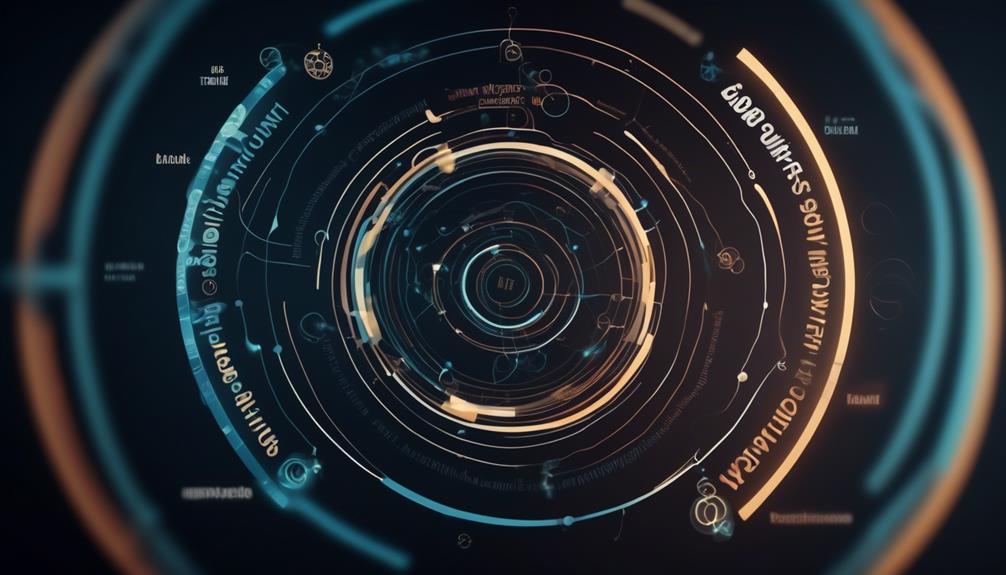From Concept to Creation: A Step-by-Step Process for Blog Infographics
If you've ever come across a visually appealing infographic that effortlessly conveyed complex information, you might have wondered about the process behind its creation. From the initial spark of an idea to the polished final product, the journey of crafting a compelling blog infographic involves meticulous planning and creative execution.
Understanding the intricacies of each step can not only streamline your workflow but also elevate the impact of your visual content. So, let's explore how a structured approach can transform your concepts into captivating infographics that resonate with your audience and drive engagement.
Key Takeaways
- Define clear objectives for strategic decisions
- Break down complex data into digestible sections
- Seek feedback from others for improvement
- Enhance coherence and clarity in design
Understanding Infographic Objectives

When diving into the realm of creating blog infographics, it's essential to first grasp the specific objectives that these visual tools aim to achieve. Understanding the objectives sets the foundation for a successful infographic. These objectives serve as guiding stars throughout the creation process, ensuring that every visual element included aligns with the overarching goal.
The primary objective of an infographic is to present information in a visually appealing and easily digestible format. Whether it's to educate, persuade, entertain, or inspire, knowing the purpose behind your infographic is key. By defining clear objectives, you can streamline the creation process and make strategic decisions about the visual elements to include.
To create an effective infographic, consider what action you want your audience to take after viewing it. Are you aiming for social shares, website traffic, lead generation, or brand awareness? By keeping these objectives in mind, you can craft a visually stunning infographic that resonates with your audience and drives results.
Researching Relevant Data
To craft a compelling and informative infographic, begin by delving into the process of gathering relevant data that will form the backbone of your visual narrative. Data analysis plays a crucial role in this phase, guiding you to extract valuable insights and trends. Through information synthesis, you can weave together disparate data points into a coherent and engaging story for your audience.
| Data Analysis | Information Synthesis |
|---|---|
| Dive deep into raw data | Connect data points creatively |
| Identify patterns and trends | Transform data into a narrative |
| Use visualization tools | Craft a compelling visual story |
| Ensure data accuracy | Provide context and relevance |
| Interpret data meaningfully | Engage the audience emotionally |
Outlining Your Infographic Structure

Having unearthed valuable insights and trends through data analysis in your quest for relevant information, it's now time to map out the structure of your infographic to ensure a captivating and coherent visual narrative. Infographic layout plays a crucial role in conveying your message effectively. Begin by deciding on the overall flow of information and how different sections will connect. Consider breaking down complex data into digestible sections, making it easier for your audience to follow along.
Visual hierarchy is key to guiding the viewer's eye through the infographic. Use varying sizes, colors, and placement of elements to emphasize important points and create a sense of order. Think about which information should stand out the most and adjust the design accordingly. Remember, simplicity can be powerful. Avoid overcrowding your infographic with excessive text or graphics as it can overwhelm the viewer.
Crafting a well-thought-out infographic layout with a clear visual hierarchy will enhance the overall impact of your content and make it more engaging for your audience.
Choosing a Design Tool
Consider the design tool that best suits your infographic creation needs to streamline your visual storytelling process effectively. Choosing the right design tool is crucial for bringing your ideas to life. When exploring graphic design software options, think about your comfort level with the tool, the complexity of the infographics you plan to create, and your budget.
Popular graphic design software like Adobe Illustrator, Canva, or Piktochart offer a range of features catering to different skill levels. Adobe Illustrator is robust and ideal for intricate designs, while Canva provides a user-friendly interface suitable for beginners. Piktochart offers templates for quick infographic creation.
If you prefer more flexibility and customization, Adobe Illustrator might be the best fit. On the other hand, if you prioritize ease of use and ready-made templates, Canva could be the way to go. Consider your specific needs and test out different tools to find the one that aligns best with your infographic creation style.
Creating Visual Elements

For enhancing your infographic design, begin by incorporating visually engaging elements that complement your chosen design tool. To make your infographic captivating and informative, consider the following:
- Visual Storytelling: Infuse your infographic with a narrative flow that guides the reader through a story. Use a combination of text and visuals to lead the viewer from one point to the next seamlessly.
- Color Psychology: Utilize graphic design techniques by leveraging the psychology of colors. Different colors evoke various emotions and associations, so choose a color palette that aligns with the message you want to convey.
- Iconography: Incorporate icons and symbols that represent key concepts in a simple and recognizable way. Icons can help break down complex information into digestible chunks, enhancing the overall clarity of your infographic.
Incorporating Text and Data
When incorporating text and data into your infographics, consider how to succinctly convey information through a combination of words and visuals.
Use data visualization techniques like charts, graphs, and icons to make complex information more digestible for your audience.
Ensure that your text complements the data presented, enhancing understanding and engagement with your infographic.
Text in Infographics
Incorporating text and data in your blog infographics can enhance visual appeal and effectively convey information to your audience. When working with text in infographics, consider the following:
- Font Pairings: Choose complementary fonts that work well together to create visual harmony and ensure readability.
- Visual Hierarchy: Organize your text in a way that guides the viewer's eye through the infographic, emphasizing key points effectively.
- Data Integration: Integrate text seamlessly with data visuals to provide context and enhance understanding.
Data Visualization Techniques
To effectively engage your audience with data visualization techniques in your blog infographics, seamlessly blending text and data is key to enhancing both visual appeal and informational value. Utilize color psychology to evoke specific emotions and guide the viewer's focus.
For example, warm tones like red and orange can convey excitement or urgency, while cooler tones like blue and green often evoke calmness or trust. Additionally, incorporate data storytelling to weave a narrative that connects the information presented, making it more relatable and memorable for your readers.
Reviewing for Coherence and Clarity

With a critical eye and a clear focus, you can enhance the coherence and clarity of your blog infographics, ensuring they effectively communicate your message to your audience. Here are three key strategies to help you review for coherence and clarity:
- Coherence Assessment: Begin by checking the flow of information in your infographic. Ensure that the data is presented in a logical sequence that's easy for your audience to follow. Look for any gaps or inconsistencies in your content that could confuse readers.
- Clarity Evaluation: Pay close attention to the visual elements of your infographic. Make sure that the design is clean and uncluttered, with fonts that are easy to read and colors that enhance rather than distract from the information. Check that all labels, legends, and explanations are clear and concise.
- Feedback Incorporation: Seek feedback from others to gain different perspectives on your infographic. Consider their suggestions for improvement and make any necessary revisions to further enhance the coherence and clarity of your visual content.
Adding Branding Elements
When adding branding elements to your blog infographics, remember to seamlessly integrate your logo for brand recognition.
Selecting a cohesive color scheme and maintaining font consistency across your infographics will help reinforce your brand identity.
These elements play a crucial role in creating a strong and memorable visual representation of your brand.
Logo Integration Tips
Incorporate your logo strategically to enhance brand recognition and maintain visual consistency in your blog infographics. Here are some logo integration tips to help you make the most out of your branding elements:
- Color Coordination: Ensure that the colors in your logo complement the overall color scheme of your infographic, creating a cohesive and harmonious look.
- Visual Hierarchy: Place your logo where it can be easily seen but doesn't overpower the main content. This maintains a clear visual hierarchy and guides the viewer's attention effectively.
- Graphic Placement: Experiment with different placements to find the one that best fits the design. Whether it's at the top, bottom, or subtly integrated within the content, make sure it adds value to the overall visual appeal.
Color Scheme Selection
To maintain a cohesive visual identity in your blog infographics, ensure that the color scheme selection aligns with your branding elements, including your logo integration.
Color psychology plays a crucial role in how your audience perceives the information you're presenting. Choose colors that not only resonate with your brand but also evoke the right emotions in your readers.
Consider the visual impact of each hue and how they work together to create a harmonious composition. Bold and vibrant colors can grab attention, while softer tones may convey a more soothing message.
Experiment with different combinations to find the perfect balance that reflects your brand's personality and captivates your audience. Remember, your color choices can significantly influence the overall effectiveness of your infographic.
Font Consistency Guidelines
Consistency in font choice across your blog infographics is paramount for integrating branding elements seamlessly and reinforcing your visual identity. To ensure your fonts align with your brand message effectively, consider the following font pairing and consistency tips:
- Font Pairing
- Choose two fonts that complement each other.
- Use one font for headers and another for body text.
- Ensure the fonts you select reflect your brand's tone and personality.
- Consistency Tips
- Stick to a maximum of two to three fonts per infographic.
- Maintain consistent font sizes for headers, subheadings, and body text.
- Align your font choices with your overall brand style guide to strengthen brand recognition.
Sharing and Promoting Your Infographic
When it comes to sharing and promoting your infographic, one effective strategy is to leverage social media platforms to reach a wider audience. Social media promotion plays a crucial role in increasing the visibility of your content. By utilizing platforms like Instagram, Twitter, and Facebook, you can engage with your followers and encourage them to share your infographic with their networks. Additionally, collaborating with influencers in your niche can amplify the reach of your infographic. Influencer collaborations bring credibility and expand your infographic's exposure to a larger audience. Another powerful tool is email marketing. Sending your infographic to your email subscribers can drive traffic to your blog and generate interest in your content.
To help you navigate the world of infographic promotion, here's a quick guide:
| Strategy | Description | Benefits |
|---|---|---|
| Social Media Promotion | Share your infographic on platforms like Instagram, Twitter, and Facebook. | Increases visibility and engagement. |
| Influencer Collaborations | Partner with influencers in your niche to reach a wider audience. | Enhances credibility and expands reach. |
| Email Marketing | Send your infographic to your email subscribers to drive traffic to your blog. | Generates interest and boosts engagement. |
Frequently Asked Questions
How Can I Ensure My Infographic Is Accessible to Individuals With Visual Impairments?
To make your infographic accessible to those with visual impairments, provide text alternatives for images, utilize descriptive captions, and consider Braille translation. This ensures screen readers can convey the content effectively and inclusively.
What Are Some Common Mistakes to Avoid When Selecting Color Schemes for Infographics?
When choosing color schemes for infographics, avoid saturation to prevent overwhelming viewers. Opt for harmonious combinations to enhance readability and visual appeal. Remember, striking a balance is key to creating engaging and accessible designs.
Is It Necessary to Include a Call-To-Action in My Infographic, and if So, How Can I Make It Effective?
Including a clear call-to-action in your infographic is crucial for boosting conversion rates and engagement. To make it effective, ensure it stands out visually, uses compelling language, and directs viewers on the desired action.
To track your infographic's success and impact online, utilize analytical tools to measure engagement metrics. Monitor social media platforms for viral reach. Stay informed on shares, likes, comments, and overall audience interaction for valuable insights.
Are There Any Copyright Considerations to Keep in Mind When Using Images or Data From External Sources in My Infographic?
When creating infographics, remember copyright compliance. Source images thoughtfully. Respect creators' rights. Use free stock sites or create original visuals. Protect your content and reputation. Give credit where it's due. Stay creative and legal.
Conclusion
Now that you've followed these steps from concept to creation, your blog infographic is ready to make a big impact. By understanding your objectives, researching data, outlining structure, choosing the right tools, and creating visually appealing elements, you've created a powerful piece of content.
Make sure to review for coherence, add branding elements, and share it to reach your audience. Your infographic is a valuable asset to engage and inform your readers. Let it shine!








